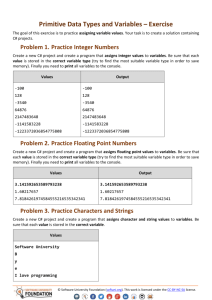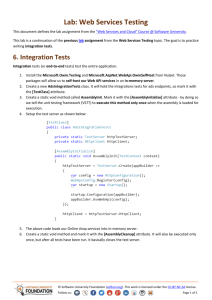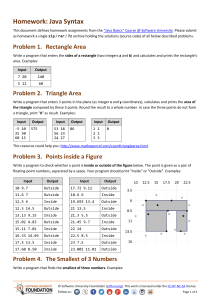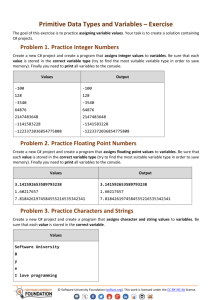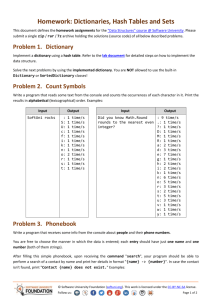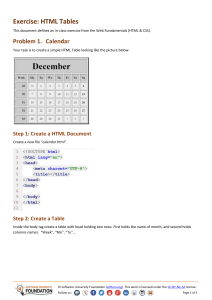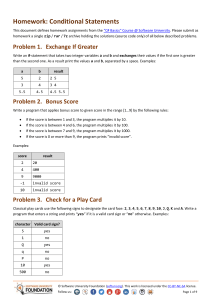C# Basics - Homework
advertisement
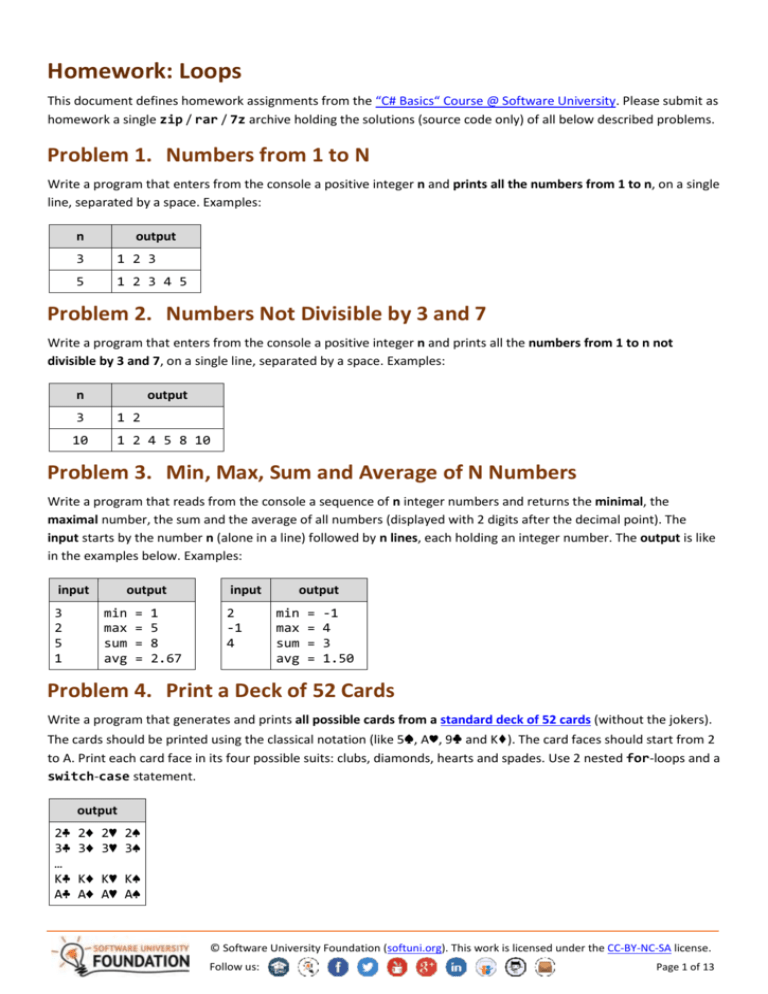
Homework: Loops
This document defines homework assignments from the “C# Basics“ Course @ Software University. Please submit as
homework a single zip / rar / 7z archive holding the solutions (source code only) of all below described problems.
Problem 1. Numbers from 1 to N
Write a program that enters from the console a positive integer n and prints all the numbers from 1 to n, on a single
line, separated by a space. Examples:
n
output
3
1 2 3
5
1 2 3 4 5
Problem 2. Numbers Not Divisible by 3 and 7
Write a program that enters from the console a positive integer n and prints all the numbers from 1 to n not
divisible by 3 and 7, on a single line, separated by a space. Examples:
n
output
3
1 2
10
1 2 4 5 8 10
Problem 3. Min, Max, Sum and Average of N Numbers
Write a program that reads from the console a sequence of n integer numbers and returns the minimal, the
maximal number, the sum and the average of all numbers (displayed with 2 digits after the decimal point). The
input starts by the number n (alone in a line) followed by n lines, each holding an integer number. The output is like
in the examples below. Examples:
input
3
2
5
1
output
min
max
sum
avg
=
=
=
=
1
5
8
2.67
input
2
-1
4
output
min
max
sum
avg
=
=
=
=
-1
4
3
1.50
Problem 4. Print a Deck of 52 Cards
Write a program that generates and prints all possible cards from a standard deck of 52 cards (without the jokers).
The cards should be printed using the classical notation (like 5♠, A♥, 9♣ and K♦). The card faces should start from 2
to A. Print each card face in its four possible suits: clubs, diamonds, hearts and spades. Use 2 nested for-loops and a
switch-case statement.
output
2♣
3♣
…
K♣
A♣
2♦ 2♥ 2♠
3♦ 3♥ 3♠
K♦ K♥ K♠
A♦ A♥ A♠
© Software University Foundation (softuni.org). This work is licensed under the CC-BY-NC-SA license.
Follow us:
Page 1 of 13
Problem 5. Calculate 1 + 1!/X + 2!/X2 + … + N!/XN
Write a program that, for a given two integer numbers n and x, calculates the sum S = 1 + 1!/x + 2!/x2 + … + n!/xn.
Use only one loop. Print the result with 5 digits after the decimal point.
n
x
S
3
2
2.75000
4
3
2.07407
5
-4
0.75781
Problem 6. Calculate N! / K!
Write a program that calculates n! / k! for given n and k (1 < k < n < 100). Use only one loop. Examples:
n
k
n! / k!
5
2
60
6
5
6
8
3
6720
Problem 7. Calculate N! / (K! * (N-K)!)
In combinatorics, the number of ways to choose k different members out of a group of n different elements (also
known as the number of combinations) is calculated by the following formula:
For example, there are 2598960 ways to withdraw 5 cards out of a standard deck of 52 cards. Your task is to write a
program that calculates n! / (k! * (n-k)!) for given n and k (1 < k < n < 100). Try to use only two loops. Examples:
n
k
n! / (k! * (n-k)!)
3
2
3
4
2
6
10
6
210
52
5
2598960
Problem 8. Catalan Numbers
In combinatorics, the Catalan numbers are calculated by the following formula:
Write a program to calculate the nth Catalan number by given n (1 < n < 100). Examples:
n
Catalan(n)
0
1
5
42
10
16796
15
9694845
© Software University Foundation (softuni.org). This work is licensed under the CC-BY-NC-SA license.
Follow us:
Page 2 of 13
Problem 9. Matrix of Numbers
Write a program that reads from the console a positive integer number n (1 ≤ n ≤ 20) and prints a matrix like in the
examples below. Use two nested loops. Examples:
n
2
matrix
1 2
2 3
n
matrix
3
1 2 3
2 3 4
3 4 5
n
4
matrix
1
2
3
4
2
3
4
5
3
4
5
6
4
5
6
7
Problem 10. Odd and Even Product
You are given n integers (given in a single line, separated by a space). Write a program that checks whether the
product of the odd elements is equal to the product of the even elements. Elements are counted from 1 to n, so the
first element is odd, the second is even, etc. Examples:
numbers
result
2 1 1 6 3
yes
product = 6
3 10 4 6 5 1
yes
product = 60
4 3 2 5 2
no
odd_product = 16
even_product = 15
Problem 11. Random Numbers in Given Range
Write a program that enters 3 integers n, min and max (min ≤ max) and prints n random numbers in the range
[min...max]. Examples:
n
min
max
random numbers
5
0
1
1 0 0 1 1
10
10
15
12 14 12 15 10 12 14 13 13 11
Note that the above output is just an example. Due to randomness, your program most probably will produce
different results.
Problem 12. * Randomize the Numbers 1…N
Write a program that enters in integer n and prints the numbers 1, 2, …, n in random order. Examples:
n
randomized numbers 1…n
3
2 1 3
10
3 4 8 2 6 7 9 1 10 5
Note that the above output is just an example. Due to randomness, your program most probably will produce
different results. You might need to use arrays.
© Software University Foundation (softuni.org). This work is licensed under the CC-BY-NC-SA license.
Follow us:
Page 3 of 13
Problem 13. Binary to Decimal Number
Using loops write a program that converts a binary integer number to its decimal form. The input is entered as
string. The output should be a variable of type long. Do not use the built-in .NET functionality. Examples:
binary
decimal
0
0
11
3
1010101010101011
43691
1110000110000101100101000000
236476736
Problem 14. Decimal to Binary Number
Using loops write a program that converts an integer number to its binary representation. The input is entered as
long. The output should be a variable of type string. Do not use the built-in .NET functionality. Examples:
decimal
binary
0
0
3
11
43691
1010101010101011
236476736
1110000110000101100101000000
Problem 15. Hexadecimal to Decimal Number
Using loops write a program that converts a hexadecimal integer number to its decimal form. The input is entered as
string. The output should be a variable of type long. Do not use the built-in .NET functionality. Examples:
hexadecimal
decimal
FE
254
1AE3
6883
4ED528CBB4
338583669684
Problem 16. Decimal to Hexadecimal Number
Using loops write a program that converts an integer number to its hexadecimal representation. The input is
entered as long. The output should be a variable of type string. Do not use the built-in .NET functionality.
Examples:
decimal
hexadecimal
254
FE
6883
1AE3
338583669684 4ED528CBB4
Problem 17. * Calculate GCD
Write a program that calculates the greatest common divisor (GCD) of given two integers a and b. Use the
Euclidean algorithm (find it in Internet). Examples:
© Software University Foundation (softuni.org). This work is licensed under the CC-BY-NC-SA license.
Follow us:
Page 4 of 13
a
b
GCD(a, b)
3
2
1
60
40
20
5
-15
5
Problem 18. * Trailing Zeroes in N!
Write a program that calculates with how many zeroes the factorial of a given number n has at its end. Your
program should work well for very big numbers, e.g. n=100000. Examples:
n
trailing zeroes of n!
explaination
10
2
3628800
20
4
2432902008176640000
think why
100000 24999
Problem 19. ** Spiral Matrix
Write a program that reads from the console a positive integer number n (1 ≤ n ≤ 20) and prints a matrix holding the
numbers from 1 to n*n in the form of square spiral like in the examples below. Examples:
n
2
matrix
1 2
4 3
n
matrix
3
1 2 3
8 9 4
7 6 5
n
4
matrix
1
12
11
10
2
13
16
9
3
14
15
8
4
5
6
7
Exam problems.**
All of the problems below are given from Variant 6 of C# Basics Practical Exam (12 July 2015 Evening). You can
submit your solutions HERE.
You are not obligated to submit any of them in your homework. We highly recommend you to try solving some or
all of them so you can be well prepared for the upcoming exam. You need to learn how to use conditional
statements, loops, arrays and other things (learn in internet how or read those chapters in the book “Fundamentals
of computer programming with C#”). If you still find those problems too hard for solving it’s very useful to check and
understand the solutions. You can download all solutions and tests for this variant here or check all previous exams.
You can also test your solutions in our automated judge system to see if you pass all tests.
Problem 20. ** Four Factors
Little Spiridon is a big NBA fan. However, since he's very good with math and not very athletic, he doesn't dream of
becoming an NBA superstar, but an NBA analyst instead. Spiro just finished reading the book “Basketball on Paper”
by Dean Oliver and is now looking to understand how the Four Factors of wining basketball games work. Will you
help little Spiridon - the NBA fan, become big Spiridon – the NBA analyst?
According to Dean Oliver, the four factors of wining basketball games, are Shooting, Turnovers, Rebounding and
Free Throws. Each factor can be applied to both the team’s offense, and defense, which basically gives us eight
factors, but we will be focusing on the Offense part only, for now.
© Software University Foundation (softuni.org). This work is licensed under the CC-BY-NC-SA license.
Follow us:
Page 5 of 13
The Shooting Factor is measured using Effective Field Goal Percentage (eFG%). The formula, by which the eFG% is
calculated, is (Field Goals (FG) + 0.5 * 3-Point Field Goals (3P)) / Field Goals Attempted (FGA).
The Turnover Factor is measured using Turnover Percentage (TOV%). The formula for the offensive TOV% is
Turnovers (TOV) / (FGA + 0.44 * Free Throw Attempts (FTA) + TOV).
The Rebounding Factor for offense is measured in Offensive Rebounding Percentage (ORB%) and the formula for it
is Offensive Rebounds (ORB) / (ORB + Opponent Defensive Rebounds (Opp DRB)).
The Free Throw factor, or the Free Throw Percentage (FT%), is by far the easiest to calculate and the formula for it is
Free Throws (FT) / FGA.
Your job is to write a program, which takes certain input parameters, calculates the four offensive factors, rounded
to the third digit after the decimal sign, and then prints them on the console. Each factor should always be a
positive number.
Input
The input data should be read from the console. It consists of eight input values, each at a separate line:
1. FG – Field Goals
2. FGA – Field Goal Attempts
3. 3P – 3-Point Field Goals
4. TOV – Turnovers
5. ORB – Offensive Rebounds
6. Opp DRB – Opponent Defensive Rebounds
7. FT – Free Throws
8. FTA – Free Throw Attempts
The input data will always be valid and in the format described. There is no need to check it explicitly.
Output
The output should be printed on the console and it should consist of four strings, each printed on a separate line in
the following format:
eFG% {factor result}
TOV% {factor result}
ORB% {factor result}
FT% {factor result}
Look at the examples below, to get a better understanding of how the output should be structured.
Constraints
All input parameters will be valid integers, in the range [1 ... 3,000,000,000 ].
Allowed working time for your program: 0.25 seconds.
Allowed memory: 16 MB.
© Software University Foundation (softuni.org). This work is licensed under the CC-BY-NC-SA license.
Follow us:
Page 6 of 13
Examples
Input
3351
7018
796
1125
967
2550
1556
2080
eFG% 0.534
TOV% 0.124
ORB% 0.275
FT% 0.222
Input
3643
7168
138
1088
1173
2171
1587
2132
Output
Comments
eFG% = (3351 + 0.5 * 796) / 7018 = 0.534
TOV% = 1125 / (7018 + 0.44 * 2080 + 1125) = 0.124
ORB% = 967 / (967 + 2550) = 0.275
FT% = 1556 / 7018 = 0.222
Output
eFG% 0.518
TOV% 0.118
ORB% 0.351
FT% 0.221
Input
2193
5293
263
957
677
2193
1090
1462
Output
eFG% 0.439
TOV% 0.139
ORB% 0.236
FT% 0.206
Problem 21. ** Detective Boev
Detective Boev is very good with decrypting messages. One day he got a message sent by general Ivanov. Knowing
the decrypting algorithm he asked his secret agent, who is learning C# in SoftUni, to write a console application for
decrypting general’s messages. Help him.
You will be given an encrypted message and a secret word.
You need to take the secret word and sum all of it’s symbols ASCII code. After that you must sum all digits until the
result is only one digit.
For example if the word is code (c + o + d + e => 99 + 111 + 100 + 101 => 411 => 4 + 1 +1 => 6 ). The mask is 6.
You must decrypt all symbols in the message. Loop over the message and check if the ASCII code of the symbol can
be devided by the mask without reminder. If so, add the mask to the simbol’s ASCII code. Otherwise, subtract it.
Finally you must reverse the message and print the result on the console.
Input
The input data should be read from the console. The input will contain exactly two lines.
The first line will hold the secret word.
The second line will hold the encrypted message.
The input data will always be valid and in the format described. There is no need to check it explicitly.
© Software University Foundation (softuni.org). This work is licensed under the CC-BY-NC-SA license.
Follow us:
Page 7 of 13
Output
The output data must be printed on the console.
On the only output line you must print the decrypted message.
Constraints
The message and the secret word will contain only characters from the ASCII table.
Allowed working time for your program: 0.1 seconds.
Allowed memory: 16 MB.
Examples
Input
C#
|wfvohyfqX#hodzwclV
Output
Software University
Input
Mask
C# => 67 + 35 => 102
=> 1 + 0 + 2 = 3
Output
Input
abc
Programming Basics 2015 0.5
;7*8&yioyg<&mtossglmulV
dofe
Output
bira
Problem 22. ** Summertime for Programmers
Dimitrichko has a dream – to become the best programmer ever. He is studying at SoftUni, investing all of his free
time doing homework and watching videos. He enjoys drinking beer, but he doesn’t have time for this. Your task is
to draw him one and make him happy. Beware that he may get tipsy very easy. Fill exactly half of the bottle with
beer.
You are given an integer number N (always odd). The width of the bottom of the bottle should be 2 * N. The width
of the top of the bottle should be N + 1. The height of the bottle should be 3 * N + 1. Check the examples below to
understand your task better.
Input
The input number N should be read from the console. It will be odd number in the range [3..59].
The input data will always be valid and in the format described. There is no need to check it explicitly.
Output
The output should be printed on the console. Use the “*” to draw the bottle and fill it with “.” and “@”. Follow the
examples below.
Constraints
N will always be a positive odd number in the range [3 … 59].
Allowed working time for your program: 0.1 seconds. Allowed memory: 16 MB.
© Software University Foundation (softuni.org). This work is licensed under the CC-BY-NC-SA license.
Follow us:
Page 8 of 13
Examples
Input
7
Input
3
Output
****
* *
* *
*....*
*....*
*....*
*@@@@*
*@@@@*
*@@@@*
******
Input
5
Output
******
*
*
*
*
*
*
*
*
*........*
*........*
*........*
*........*
*........*
*@@@@@@@@*
*@@@@@@@@*
*@@@@@@@@*
*@@@@@@@@*
*@@@@@@@@*
**********
Output
********
*
*
*
*
*
*
*
*
*
*
*
*
*............*
*............*
*............*
*............*
*............*
*............*
*............*
*@@@@@@@@@@@@*
*@@@@@@@@@@@@*
*@@@@@@@@@@@@*
*@@@@@@@@@@@@*
*@@@@@@@@@@@@*
*@@@@@@@@@@@@*
*@@@@@@@@@@@@*
**************
Problem 23. ** Light the Torches
Father Haralambi is an Orthodox priest, who is serving in the small Elin Pelinian monastery. During the day, Father
Haralambi mostly prays and, since he's a casual fisherman, on Sundays, he goes to the river near the monastery and
tries to catch his own dinner. In the evenings, it's Father Haralambi's duty, to go down to the unusually large
monastery basement and light the torches in each room. He is a good Orthodox priest and as such he is not fully
sober in the evenings, thus he sometimes is not able to light all the torches. Every morning, after the morning
prayer, the father counts the rooms that are dark and using a certain formula that he created, calculates the number
of prays that he has to say during the day, in order to make up for the rooms that he wasn't able to reach. Your job
is to create a program, which will monitor Father Haralambi's movements in the basement and automate the
calculation process, thus allowing him to focus on praying, rather than lose precious time doing math.
The monastery's basement is linear and there is only one single door connecting two adjacent rooms. The only
entrance to the basement, is in the room that's in the middle of the basement – the rooms on the left from the
entrance will always be equal to the number of rooms on the right from the entrance. The total number of rooms
will be an odd number N.
You will receive a string of characters, which will tell you which rooms are currently lit and which rooms are dark.
The string can have a length less than or equal to the number of rooms. It will contain only two types of characters,
'L' for light and 'D' for dark and each character will represent the state of a single room.
Your first task is to go through all the rooms, starting from the leftmost room (room 0), and update the state of each
room, using the characters in the string from left to right. If you reach the end of the string before you reach the
end of the basement, go back at the beginning of the string and continue.
© Software University Foundation (softuni.org). This work is licensed under the CC-BY-NC-SA license.
Follow us:
Page 9 of 13
After the rooms’ state has been updated, Father Haralambi will enter the basement from the only entrance and you
are to begin monitoring his movements. The movements will be represented as a series of commands, each
provided on a separate line. The possible commands are RIGHT X, LEFT X and END, with X being the number of
rooms that the priest passes through and LEFT/RIGHT being the direction that he's walking in.
For example, if the priest is currently in room 2 and the command RIGHT 3 is received that will mean that the priest
will end up in room 6 – he passes through 3 rooms and ends up in the next one. Respectfully, if he is currently in
room 5 and you receive the command LEFT 3, the priest will wind up in room 1. When the priest stops walking, he
will update the state of the current room. If the room is dark, then he will light it up and if the room is already lit, he
will stumble upon the torch and the room will become dark. The priest updates only the rooms that he ends up in
and not the ones that he passes through, while trying to get there. Also, don't forget that the priest is not quite
sober, so he may try to go to rooms that do not exist. For example, if he is in room 0, he does a RIGHT 6 movement,
but the basement has only 5 total rooms, then he will end up in the last room on the right, which will be room 4. If
the priest does not change rooms, after you receive a command, then the state of the current room is not changed.
When you receive the END command, that means the priest has fallen asleep and you should start calculating his
prays for the next day.
Once the priest has fallen asleep, go through the entire basement and count the rooms that are still dark. The total
number of prays that Father Haralambi has to say, when he wakes up, is equal to the ASCII code of the character 'D'
multiplied by the number of dark rooms.
Input
The input data should be read from the console.
On the first line you will receive an ODD number N, specifying the total number of rooms in the basement.
On the second line, you will receive a string, containing a series of 'L' and 'D' characters.
On the next lines, you will receive a series of commands in the described formats. The input ends when the
END command is received.
The input data will always be valid and in the format described. There is no need to check it explicitly.
Output
The output should be printed on the console and should consist of a single number. The number is the total number
of prays.
Constraints
The number N will be a valid ODD integer in the range [1 ... 99].
The string has length less than or equal to N and will NOT contain any white spaces.
Each command will be provided on a separate line in the format: RIGHT {X} / LEFT {X} / END
The number X will always be a valid integer in the range [0 ... 100].
The number of commands will be in the range [1 ... 202].
Allowed working time for your program: 0.25 seconds.
Allowed memory: 16 MB.
© Software University Foundation (softuni.org). This work is licensed under the CC-BY-NC-SA license.
Follow us:
Page 10 of 13
Example
Input
5
LD
LEFT 0
LEFT 20
RIGHT 2
LEFT 2
END
Output
0
Comments
5 total rooms and string “LD” (The grey cell marks the current position of the priest):
L
D
L
D
L
LEFT 0 – the priest moves to the Left passing through 0 rooms:
L
L
L
D
L
LEFT 20 – the priest goes as far Left as he can:
D
L
L
D
L
RIGHT 2 – the priest goes to the Right passing through 2 rooms:
D
L
L
L
L
LEFT 2 – priest goes to the Left passing through 2 rooms:
L
L
L
L
L
END – we stop receiving commands, we calculate the number of prays and we print
the result on the console:
0 Dark Rooms * (ASCII code of 'D') = 0
© Software University Foundation (softuni.org). This work is licensed under the CC-BY-NC-SA license.
Follow us:
Page 11 of 13
Problem 24. ** Wiggle Wiggle
Nakov likes Hip-hop music. He got inspired by the music clips he saw on YouTube and now he really wants to learn
how to twerk. You got to help him to accomplish his goal. Since he is a lot into bits, you need to use bitwise
operations.
You are given a sequence of 64 bit integer numbers on one line, separated by a space. You have to take each
consecutive pair of numbers (first with second, third with fourth and so on). Then you have to pass through the bits
from right to left and switch every bit at even positions from these two numbers. Assume the position ‘0’ is even.
For example, the first number pair is 36854775807 and 2285477580.
36854775807
000000000000000000000000000100010010100101101110011111111111111
2285477580
000000000000000000000000000000010001000001110011001111011001100
After switching, the numbers are:
36519493358
000000000000000000000000000100010000000101100110011111011101110
2554175453
000000000000000000000000000000010011100001111011001111111011101
In the end, you need to reverse the whole two numbers bitwise. The final result is:
9223372000335806737
111111111111111111111111111011101111111010011001100000100010001
9223372034233491490
111111111111111111111111111111101100011110000100110000000100010
Input
The input data should be read from the console. It consists of a sequence of 64-bit integer numbers, separated by a
space. The sequence count will always be an even number.
The input data will always be valid and in the format described. There is no need to check it explicitly.
Output
Print each of the obtained numbers on a single line in the following format:
{decimal} {binary}
Constraints
Every input number will be a 64-bit integer in the range [0 … 9,223,372,036,854,775,807].
The sequence count will always be an even number.
Allowed working time for your program: 0.1 seconds.
Allowed memory: 16 MB.
Hint: You should print all 63 bits in the final result for each number (without the sign bit).
© Software University Foundation (softuni.org). This work is licensed under the CC-BY-NC-SA license.
Follow us:
Page 12 of 13
Examples
Input
36854775807 2285477580
Output
9223372000335806737 111111111111111111111111111011101111111010011001100000100010001
9223372034233491490 111111111111111111111111111111101100011110000100110000000100010
Input
4558 488755 25 555
Output
9223372036854426212
9223372036854632089
9223372036854775798
9223372036854775236
111111111111111111111111111111111111111111110101010101001100100
111111111111111111111111111111111111111111111011100111010011001
111111111111111111111111111111111111111111111111111111111110110
111111111111111111111111111111111111111111111111111110111000100
Input
5436 4266 64367 234256 423456 2
Output
9223372036854771671
9223372036854770241
9223372036854662341
9223372036854590650
9223372036854635999
9223372036854492157
111111111111111111111111111111111111111111111111110111111010111
111111111111111111111111111111111111111111111111110101001000001
111111111111111111111111111111111111111111111100100010011000101
111111111111111111111111111111111111111111111010010110010111010
111111111111111111111111111111111111111111111011101110111011111
111111111111111111111111111111111111111111110111010101111111101
© Software University Foundation (softuni.org). This work is licensed under the CC-BY-NC-SA license.
Follow us:
Page 13 of 13
